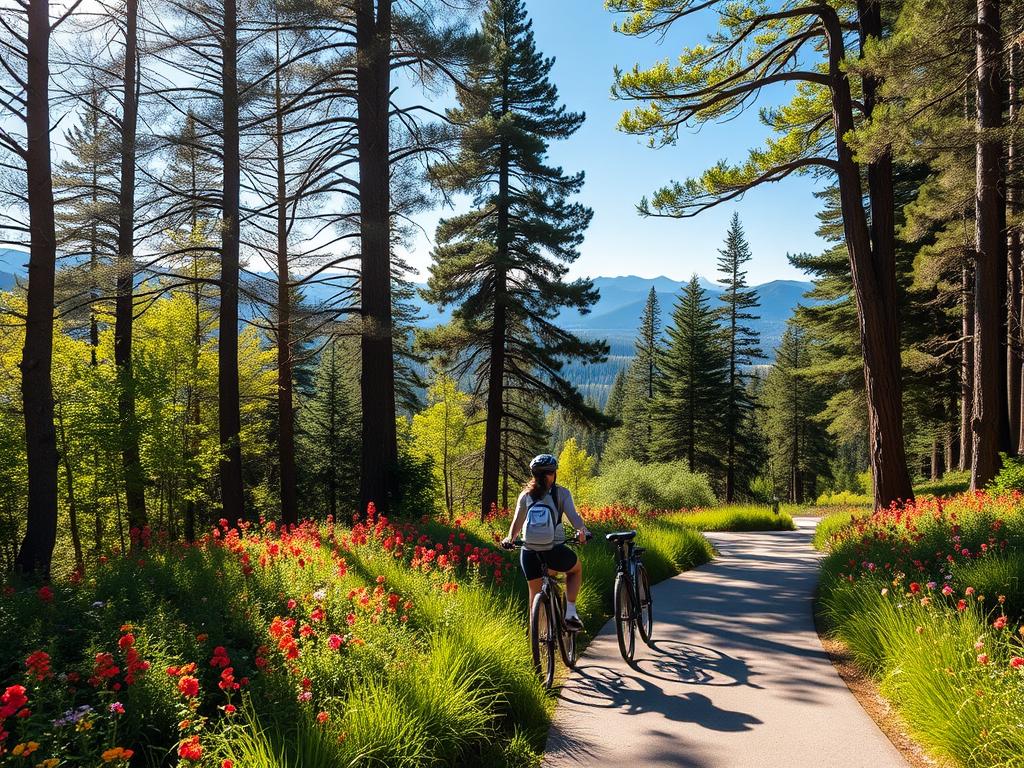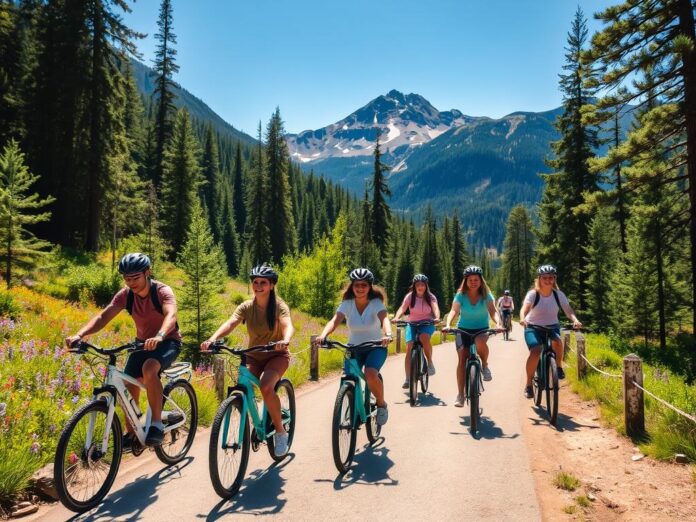Electric bicycles, or e-bikes, are becoming more popular. The National Park Service has welcomed them in national parks across the U.S. In the fall of 2019, they set a policy for e-bikes in all national parks. They recognized three types of these vehicles.
Class 1 e-bikes help you pedal up to 20 mph. Class 2 e-bikes have a throttle that goes up to 20 mph. Class 3 e-bikes can pedal-assist up to 28 mph. Each park has its own rules about which e-bikes are allowed on certain trails.
Key Takeaways
- The National Park Service has adopted an official policy regarding electric bikes in all national parks.
- E-bikes are allowed to operate in parks with the same restrictions and regulations as non-electric bicycles.
- Three classes of e-bikes are recognized: Class 1 (pedal assist up to 20 mph), Class 2 (throttle assist up to 20 mph), and Class 3 (pedal assist up to 28 mph).
- Individual parks have specific policies regarding which classes of e-bikes are permitted on certain trails.
- Several national parks, such as Crater Lake, Acadia, Zion, and Saguaro, have opened up e-bike access on select trails and roads.
Introduction to E-Biking in National Parks
The National Park Service (NPS) now allows electric bicycles (e-bikes) in national parks. This change makes exploring the outdoors more accessible and green. E-bikes help riders of all fitness levels tackle tough trails and go further, making adventures fun for everyone.
Benefits of E-Biking for Groups
E-bikes are great for group trips in national parks. They help people of all ages and abilities join in. This means friends and family can enjoy nature together. Plus, e-bikes let older riders keep cycling, enjoying the ride for years.
Eco-Friendly Travel Options
E-bikes are also good for the environment in national parks. They cut down on gas use, helping to keep parks beautiful. The National Park Service supports e-bikes, seeing them as a way to reduce traffic and protect nature.
Exploring Nature on Two Wheels
E-bikes have opened up new paths for group adventures in national parks. They let riders see more trails and enjoy the scenery. Whether on mountain roads, lakeshores, or single-track trails, e-bikes make exploring exciting and memorable.
“E-bikes have revolutionized the way we experience national parks, making them more accessible and eco-friendly for groups of all abilities.”
Top National Parks for E-Bike Access
Eco-friendly outdoor activities and family-friendly park explorations are now easier with e-bikes. Many national parks in the U.S. welcome group e-biking adventures. This lets visitors enjoy nature on two wheels and lower their carbon footprint.
Yellowstone National Park
Yellowstone National Park is famous for its wildlife and geothermal wonders. It allows Class 1 e-bikes on all roads, including the Grand Loop. Visitors can enjoy eco-friendly outdoor activities and see amazing views on the park’s roads.
Zion National Park
Zion National Park in Utah is great for family-friendly park explorations. It’s e-bike-friendly, with Class 1 e-bikes okay on all roads, like the Zion Canyon Scenic Drive. This lets visitors try sustainable park transportation options.
Acadia National Park
Acadia National Park in Maine has many carriage roads and bike paths for Class 1 e-bikes. Visitors can enjoy eco-friendly outdoor activities and family-friendly park explorations on the park’s trails.
Grand Canyon National Park
Grand Canyon National Park in Arizona has sustainable park transportation options. Class 1 e-bikes are allowed on multi-use pathways. Riders can see the canyon’s beauty while doing eco-friendly outdoor activities and family-friendly park explorations.
Other parks like Crater Lake National Park, Everglades National Park, and Saguaro National Park also welcome e-bikes. Each offers special chances for group e-biking adventures.

E-Bike Rentals and Tours in National Parks
Exploring national parks is now easier with e-bike rentals and tours. Parks offer many e-bike models for all skill levels. You can choose from guided tours or go solo to see the park’s beauty.
Local Rental Shops
Local shops near park entrances have a wide range of e-bikes. They have light bikes for easy trails and tough bikes for hard terrain. The staff helps you pick the right bike and adjust it for you.
Guided E-Bike Tours
For a guided trip, many parks work with local outfitters for electric bike tours. These tours show you the park’s best spots. They’re great for groups or if you’re new to e-bikes.
DIY E-Bike Routes
For a self-guided trip, parks give info on e-bike rentals and routes. You can find hidden spots and enjoy the ride at your pace. Just follow the rules and maps to make your trip special.
“The freedom and accessibility of e-bikes have truly transformed the way we experience national parks. Visitors of all ages and abilities can now explore these natural wonders on two wheels, immersing themselves in the sights and sounds of the great outdoors.”
What to Expect on an E-Bike Adventure
Exploring national parks on an e-bike is a thrilling experience. You’ll find different terrains and trail conditions, from smooth roads to rough paths. These electric bikes make uphill climbs easy and let you travel further.
Terrain and Trail Conditions
E-bike trails in national parks vary for all skill levels. You might ride on paved paths or tackle off-road trails. Your e-bike helps you navigate these landscapes with ease.
Points of Interest Along Routes
As you ride, you’ll see stunning views, historical sites, and wildlife. Enjoy mountain vistas, calm lakes, and dense forests. Keep an eye out for plants and animals, and take photos of the amazing sights.
Safety Tips and Regulations
When biking in national parks, safety is key. Each park has its own rules, like speed limits and trail use. Know the park’s e-bike policies and wear safety gear like helmets and gloves. This way, you can have a safe and fun trip.
Knowing about the terrain, attractions, and safety rules lets you enjoy national park e-bike trails fully. You’ll make lasting memories and connect with nature in a unique way.
Group E-Biking: Planning Your Trip
Going on a group e-biking adventure in national parks is fun and good for the environment. It’s key to think about the right group size, when to go, and what to pack. This ensures everyone has a great time.
Ideal Group Sizes for E-Bikes
The best number of people for an e-bike trip is 4 to 8. This size makes it easy to move together, talk, and enjoy the ride. More than 8 can face problems like finding trails and keeping up.
Scheduling and Timing Your Experience
When you plan your e-bike trip, timing is everything. Look up the park’s hours, weather, and how busy it gets. Try to go when it’s not too crowded, like weekdays or off-peak hours.
Packing Essentials for E-Bike Outings
- Properly fitted helmets for all riders
- Sufficient water and snacks to fuel your adventure
- Appropriate clothing for the weather and terrain
- Basic repair tools in case of minor mechanical issues
- Portable chargers for your e-bike batteries
- Map of the park and trail system
Before you start, learn about the park’s rules and how to ride right. This way, you can enjoy your trip more and help keep the park beautiful.
Accessibility Considerations for E-Bike Users
As e-bikes become more popular, national parks are welcoming them. They help make outdoor adventures open to everyone. Parks now offer accessible national park adventures, e-bike rentals, and guided e-bike excursions for all.
Trail Accessibility for All Abilities
Many national parks have trails for all skill levels. Some trails are for experienced riders, but parks are adding more accessible ones. Park rangers or guides can help pick the best trail for your group.
Rental Options for Specialized E-Bikes
More e-bike rental shops near parks offer bikes for specific needs. You can find tricycles, tandem bikes, and more. These bikes are designed for comfort and safety. Look up rental options early to make sure you have the right bike.
Keeping Everyone Engaged in the Experience
Plan your e-bike trip with routes that have lots of sights and breaks. This keeps everyone interested and happy. Ask park rangers or guides for the best routes for your group.

“E-bikes have opened up national parks to a whole new audience, making the great outdoors more accessible than ever before.”
National parks are making e-biking accessible to more people. Whether it’s a group trip or solo, there are many options. Make sure to find the right one for a fun and inclusive ride.
Environmental Impact of E-Biking
E-biking in national parks is becoming more popular. It’s a green way for visitors to get around. But, we must think about how it affects wildlife and nature. We should use trails wisely and join conservation efforts.
Reducing Carbon Footprints
E-bikes are better than cars for the environment. Before a new rule in November 2020, over 380 parks allowed e-bikes. Most parks still don’t let bikes on roads or trails.
Wildlife Conservation Awareness
E-biking makes nature more accessible. But, we must remember its effects on animals and their homes. The National Park Service is studying how e-bikes impact the environment.
Supporting Park Preservation Efforts
Many parks welcome e-biking as part of their green plans. Visitors can help by following rules and joining conservation projects. This way, e-bike riders help protect nature for the future.
| Key Statistic | Value |
|---|---|
| E-bike sales in the EU and UK (2020) | 4.6 million units, a 52% increase year-on-year |
| Adult bikes sold in the UK that are electric | Nearly one in three |
| Pending NEPA analysis for the e-bike rule | A programmatic environmental assessment (PEA) is being prepared by the National Park Service |
“The use of tracking apps like Strava to compete among e-bikers may lead to irresponsible behavior, trail damage, and surface erosion, pointing to potential negative impacts on the environment.”
E-Bike Maintenance Tips
Keeping your e-bike in top shape is key for a fun and safe ride on e-bike trails in national parks. Regular care makes sure your electric bike works well and lasts longer. Here are some tips to keep your electric bike tours in perfect condition.
Basic Maintenance for a Smooth Ride
First, always check your tire pressure and charge the battery fully before you ride. Also, don’t forget to oil the chain to avoid damage. These easy steps will help your sustainable park transportation run smoothly and last longer.
Troubleshooting Common Issues
Learn about common problems like battery drain or motor issues. Knowing how to fix these can save you time and trouble. Check your manual or ask a local bike shop for help with fixing these problems.
Preparing for Day Trips
Before heading out on day trips in national parks, make sure your e-bike is charged. Also, carry a basic repair kit with you. This kit should have spare parts, tools, and supplies for quick fixes. Knowing where to find charging stations in the park can also help keep your ride uninterrupted.
| Maintenance Tip | Benefit |
|---|---|
| Check tire pressure | Ensures a comfortable and efficient ride |
| Lubricate the chain | Reduces wear and tear, improves performance |
| Carry a repair kit | Allows for quick fixes on the trail |
| Locate charging stations | Ensures your e-bike is ready for the next leg of your adventure |

“E-bikes make cycling more accessible for riders of all ages and fitness levels, providing a more comfortable experience than traditional bikes.”
Safety and Etiquette on Trails
Exploring e-bike trails in national parks requires safety and respect. Always follow the rules, including speed limits and directions. Be polite and use signals to warn others you’re coming.
Sharing Trails with Other Users
National parks welcome many outdoor lovers, like hikers and cyclists. Be careful when passing others and keep a safe distance. Avoid sudden moves that might scare them.
Guidelines for Group Riding
When biking with friends, set rules for riding together. Keep a safe gap between each rider and don’t block the path. Choose a leader to guide the group and keep everyone together.
Staying Safe in Wildlife Areas
Many parks have wild animals, so it’s key to respect their space. Keep an eye out for animals and stay far away. Slow down or stop if needed to avoid scaring them.
Your safety and the parks’ preservation are important. By following the rules and being considerate, you’ll have a great time biking. Plus, you’ll help protect these beautiful places for future visitors.
Seasonal Considerations for E-Biking
The best times for e-biking in national parks vary by location and climate. Everglades and Saguaro are great in winter. Spring and fall are better for other parks. Always check the weather and pack the right gear.
Best Times of Year for E-Biking
The best time for e-biking depends on the weather and trail conditions. Summer is busy, but spring and fall are often better. These seasons offer more comfortable rides and fewer people.
Weather Preparedness for Group Rides
Weather is key for group e-bike rides. Temperature, rain, and wind can change quickly. Always check the forecast and bring layers, rain gear, and more to be ready for anything.
Seasonal Trail Conditions to Watch Out For
Trail conditions change with the seasons. Spring trails can be muddy and slippery. Winter trails may have snow and ice. Check park websites or visitor centers for updates before and during your ride.
| National Park | Best Seasons for E-Biking | Potential Seasonal Challenges |
|---|---|---|
| Yellowstone National Park | Spring, Summer, Fall | Snow and ice in winter, mud and flooding in spring |
| Zion National Park | Spring, Fall | High temperatures and crowds in summer, occasional flash floods |
| Acadia National Park | Spring, Summer, Fall | Fog and wind in coastal areas, ice and snow in winter |
| Grand Canyon National Park | Spring, Fall | Extreme heat in summer, snow and ice in winter |
Knowing the best times, preparing for the weather, and checking trail conditions ensures a great e-biking trip. Always check park websites and local resources for updates. This helps plan your scenic e-bike routes and sustainable park transportation.
Real-Life Experiences: E-Biking in National Parks
Exploring national parks on an e-bike is thrilling and easy for friends and families. It lets them see wildlife and reach amazing views together. Real e-bike fans share their joy of family-friendly park explorations and accessible national park adventures.
Testimonials from Group Riders
“Our group e-bike trip through Yosemite was the highlight of our summer. Being able to conquer the trails and inclines together was an incredible bonding experience. The e-bikes made it possible for everyone to keep up, even those with less cycling experience.”
– Sarah, 42, California
“As a person with limited mobility, I was hesitant to try e-biking in a national park. But the rental shop at Glacier National Park had the perfect specialized e-bike for me, and I was able to explore the stunning landscapes alongside my friends. It was a game-changer for my outdoor adventures.”
– Michael, 58, Montana
Memorable Moments Shared with Friends
Many cherish the moments of group e-bike access in national parks. They include unexpected encounters and shared victories. Whether it’s seeing elk or beating a tough incline, these moments last a lifetime.
- Watching the sun set over the Grand Canyon from the Rim Trail
- Coasting through fields of wildflowers in Glacier National Park
- Stopping for a picnic lunch with stunning mountain views in Denali
The friendship and pride of riding e-bikes in national parks make these family-friendly park explorations unforgettable.
Conclusion: Why Choose E-Biking in National Parks
E-biking in national parks is a mix of adventure, easy access, and green exploration. It lets groups travel far, tackle tough trails, and see beautiful views while being kind to the environment. More parks now welcome e-bikes, showing a push for everyone to enjoy the outdoors and travel green.
Key Takeaways for Outdoor Enthusiasts
E-biking in national parks is great for both seasoned cyclists and newbies. It lets you go further, see more, and enjoy the trip without the old limits. This makes exploring America’s natural beauty easier and more fun.
Encouragement to Explore and Enjoy Nature
E-biking is a fresh chance for groups to see national parks in a green way. It lets you reach far-off spots and dive into amazing landscapes. You can connect with nature and make memories with friends. Exploring national parks by e-bike is a green adventure that lets you fully enjoy the outdoors.
Final Thoughts on Group E-Biking Adventures
In short, e-biking in national parks is a big deal for outdoor fans. It mixes excitement with easy access and green travel, making parks welcoming for everyone. Whether it’s a group trip or a solo journey, e-biking is a special way to see the outdoors and make memories that last a lifetime.






